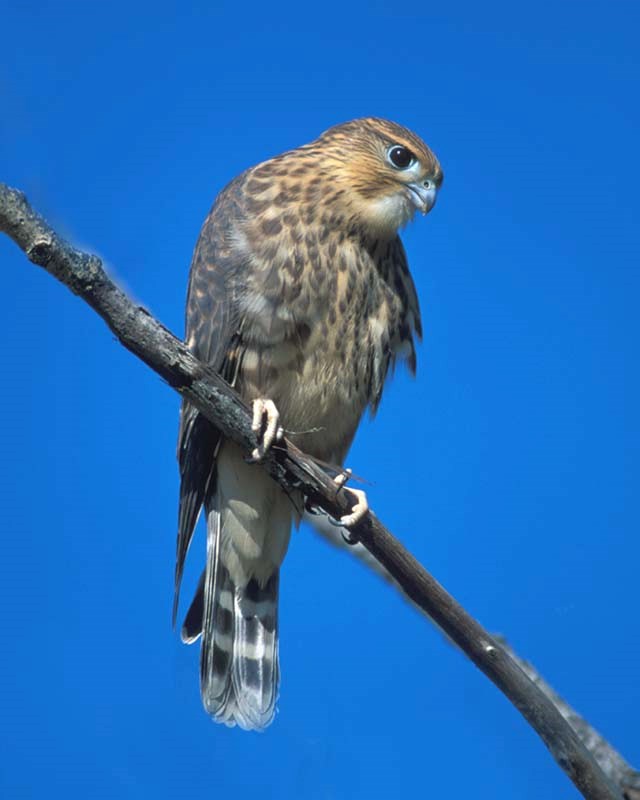Ever heard this sound? "Ki, kiii, kiIII, KI-KI-KI-KI-KI-KI-KI…kee!" I've heard this strident, hyperactive, and mildly irritating bird call many times around St. Albert, usually without any warning.
Ever heard this sound? "Ki, kiii, kiIII, KI-KI-KI-KI-KI-KI-KI…kee!"
I've heard this strident, hyperactive, and mildly irritating bird call many times around St. Albert, usually without any warning. I'll be sitting by the window minding my own business when all of a sudden KI-KI-KI-KI-KI! I've never been able to figure out what's causing it or where it's coming from.
Turns out it was a wizard. Specifically, a merlin.
The merlin is a medium-sized falcon with a hooked nose, sharp wings, and the aforementioned distinct call, says Gordon Court, a biologist with Alberta Fish and Wildlife and a specialist in raptors. "They used to call them pigeon hawks," he notes, on account of their size. Males will have a beautiful powder-blue back, while females will be brown-backed. Both have brown stripes on their white chests.
Merlins sound like peregrine falcons, Court notes, but have about half the wingspan. Peregrines also nest in very high buildings, whereas merlins prefer trees. Merlins can also be mistaken for American kestrels, which are slower, spotted, and have more red and blue on them.
Local birder Peter Demulder says he always looks up whenever he hears a merlin – usually just in time to see it zip by at fantastic speeds. "It's a lovely sight to see." Merlins often hang around the Cajun House building downtown, he notes, picking off pigeons under the St. Albert Trail bridge.
Merlins are found throughout Europe, Asia and North America, notes Jocelyn Hudon, head of ornithology for the Royal Alberta Museum. "They're fairly cryptic," he notes, and are often tough to spot if they're not calling. Their name comes from the French word "esmerillon."
Merlins were nearly wiped out a few decades ago in Alberta by pesticides, Court notes, but they've since bounced back. They've also started overwintering here, feeding on flocks of bohemian waxwings drawn to cities by berry trees.
This is mating season for the merlin, Hudon says, so expect to see a lot of power dives, circling, and other tricks from them. Males will often give females gifts of food as well.
Most mating pairs will be exceptionally noisy during and after courtship, Court says, and call constantly. "Just enjoy them and know that in a few weeks they'll be as quiet as a mouse."
By August, Court says, we'll see young merlins honing their hunting skills chasing dragonflies, their parents and each other at breakneck speeds – literally, in some cases, due to inexperience. Many young ones will die from such high-speed collisions.
Merlins are best known for their spectacular aerial hunts. You'll often see them flying very low over the rooftops, Court says, wings pumping, as they chase birds such as bohemian waxwings, which, like the merlin, occasionally overwinter here.
The hunt begins as the merlin darts towards the flock, attempting to pick off a bird unawares. This startles the flock, which jets off, forming a big roiling ball of wings and feathers with a merlin underneath.
"Everyone in the flock usually tries to get to the inside of the group," Court notes, and the merlin will try to snag anyone that decides to break for cover or strays too close to the outside. If a waxwing reaches cover, it's usually safe; unlike the sharp-shinned hawk, merlins don't have the maneuverability to navigate trees.
Still, some birders accuse merlins of gobbling up local songbirds.
While merlins can spook birds away from a region, Court notes that they're unlikely to put much of a dent in the population. "The depredation of any single pair of merlins is going to be a fraction of the local cats," he said. "They certainly don't eliminate bird species from areas."
They also tend to target house sparrows, which are an invasive species. Research by the University of Saskatchewan suggests that up to 70 per cent of a merlin's diet comes from house sparrows, Court says.
Merlins are ultimately a sign of a healthy bird population, Court says, as you won't have them if you don't have plenty of birds. "We nearly lost them at one point, and to have them right in town is a really cool thing."
Merlin
Name:<br />Falco colombarius.<br /><br />Appearance:<br />Small hawk with long, pointed wings, brown streaked belly and a grey or brown back.<br /><br />Commonly heard:<br />Making a strident "ki-ki-ki" sound.<br /><br />Occasionally confused with:<br />Peregrine falcons, which are bigger.<br /><br />Fun fact:<br />A group of them is a "brace," "leash," or an "illusion" of merlins.
Wild St. Albert
Like wildlife? So do we! Every second Wednesday the Gazette profiles a reasonably common wild creature in the St. Albert region. Birds, beasts, bugs, fish … so long as it's alive and kicking, we'll feature it. <br /><br />Got a creature you'd like to see profiled? Send your suggestions to [email protected].




